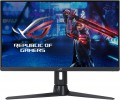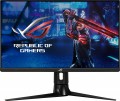Surface treatment
Modern monitors can use displays with both glossy and matte screen surfaces.
A matte surface is in some cases more preferable due to the fact that on a
glossy screen, when exposed to bright light, noticeable glare appears, sometimes interfering with viewing. On the other hand, glossy screens offer better picture quality, higher brightness, and richer colours.
Due to the development of technology,
monitors with a special anti-glare coating have appeared on the market, which, while maintaining all the advantages of a glossy screen, creates significantly less visible glare in bright ambient light.
Refresh rate
The maximum frame rate supported by the monitor at the recommended (maximum) resolution.
The higher the frame rate, the smoother the movement on the screen will look, the less noticeable jerks and blurring will be on it. Of course, the actual image quality also depends on the video signal, but for normal viewing of video at a high frame rate, the monitor must also support it.
When choosing this option, keep in mind that at lower resolutions than the maximum, the supported frame rate may be higher. For example, a model with a 1920x1080 matrix and a claimed frame rate of
60 Hz at a reduced resolution can give 75 Hz; but the
75Hz frame rate is only listed in the specs if it is supported at the monitor's native (maximum) resolution.
Also note that a high frame rate is especially important for gaming models (see "Type"). In most of them, this figure is
120 Hz and higher;
monitors with a frequency of 144 Hz are considered the best option in terms of price and quality, however, there are also higher values —
165 Hz and
240 Hz. And
monitors at 100 Hz can be both inexpensive gaming models and advanced home ones.
You can evaluate all the frame rates at which this monitor is capable of operating by the ver
...tical frequency claimed in the specifications (see below).Brightness
The maximum brightness provided by the monitor screen.
Choosing
a monitor with high brightness is especially important if the device is going to be used in bright ambient light — for example, if the workplace is exposed to sunlight. A dim image can be "dampened" by such lighting, making work uncomfortable. In other conditions, the high brightness of the screen is very tiring for the eyes.
Most modern monitors give out about 200 – 400 cd / m2 — this is usually quite enough even in the sun. However, there are also higher values: for example, in LCD panels (see "Type") the brightness can reach several thousand cd/m2. This is necessary taking into account the specifics of such devices — the image must be clearly visible from a long distance.
Dynamic Contrast
Dynamic contrast provided by the monitor screen.
Dynamic contrast refers to the difference between the brightest white at maximum backlight intensity and the deepest black at minimum backlight. In this way, this indicator differs from static contrast, which is indicated with a constant backlight level (see above). Dynamic contrast ratio can be expressed in very impressive numbers (in some models — more than 100,000,000: 1). However, in fact, these figures are poorly correlated with what the viewer sees: it is almost impossible to achieve such a difference within one frame. Therefore, dynamic contrast is most often more of an advertising than a practically significant indicator, it is often indicated precisely in order to impress an inexperienced buyer. At the same time, we note that there are "smart" backlight technologies that allow you to change its brightness in certain areas of the screen and achieve a higher contrast in one frame than the claimed static one; these technologies are found mostly in premium monitors.
Colour depth
The colour depth supported by the monitor.
This parameter characterizes the number of shades that the screen can display. And here it is worth recalling that the image in modern monitors is based on 3 basic colours — red, green, blue (RGB scheme). And the number of bits is indicated not for the entire screen, but for each base colour. For example, 6 bits (the minimum colour depth for modern monitors) means that the screen is capable of producing 2 ^ 6, that is, 64 shades of red, green and blue; the total number of shades will be 64 * 64 * 64 = 262,144 (0.26 million). An
8-bit colour depth (256 shades for each base colour) already gives a total of 16.7 million colours; and the most advanced modern monitors support
10-bit colour, allowing you to work with more than a billion shades.
Screens with support for FRC technology are worth a special mention; nowadays, you can find models marked "
6 bit + FRC " and "
8 bit + FRC ". This technology was developed to improve picture quality in situations where the incoming video signal has a greater colour depth than the screen, such as when 10-bit video is fed to an 8-bit matrix. If such a screen supports FRC, the picture on it will be noticeably better than on a regular 8-bit monitor (although somewhat worse than on a full-fledged 10-bit monitor, but “8 bit + FRC” screens are much
...cheaper).
High colour depth is important primarily for professional graphics and other tasks that require high colour fidelity. On the other hand, such features significantly affect the cost of the monitor. In addition, it is worth remembering that the quality of colour reproduction depends not only on the colour depth, but also on other parameters — in particular, colour gamut (see below).Colour space (sRGB)
Monitor colour gamut Rec. 709 or sRGB.
Any colour gamut is indicated as a percentage, however, not relative to the entire variety of visible colours, but relative to the conditional colour space (colour model). This is due to the fact that no modern screen is able to display all the colours visible to humans. However, the larger the colour gamut, the wider the monitor's capabilities, the better its colour reproduction.
Nowadays, sRGB is actually the standard color model adopted for computer technology; This is what is used in the development and production of most video cards. For television, the Rec. standard, similar in parameters, is used. 709. In terms of the range of colors, these models are identical, and the percentage of coverage for them is the same. In the most advanced monitors it can
reach or even exceed 100%; These are the values that are considered necessary for high-end screens, incl. professional.
Colour gamut (DCI-P3)
The color gamut of the monitor according to the DCI P3 color model.
Any color gamut is indicated in percentages, but not relative to the entire variety of visible colors, rather relative to a conventional color space (color model). This is because no modern screen can display all the colors visible to the human eye. Nevertheless, the larger the color gamut, the broader the monitor's capabilities, and the better its color reproduction quality.
DCI P3 is a professional color model mainly used in digital cinemas. It is significantly broader than the standard sRGB, providing more accurate and high-quality colors. Accordingly, the percentage values are lower—for example, 115% coverage in sRGB corresponds to approximately 90% coverage in DCI P3; in the most advanced modern monitors, coverage according to this standard is
98 – 100%. At the same time, supporting DCI-P3 is costly, which is why it is mainly found in high-end monitors for professional and gaming purposes.
HDR
This technology is designed to expand the range of brightness reproduced by the monitor; Simply put, an HDR model will display brighter whites and darker blacks than a "regular" display. In fact, this means a significant improvement in colour quality. On the one hand, HDR provides a very "live" image, close to what the human eye sees, with an abundance of shades and tones that a normal screen cannot convey; on the other hand, this technology allows to achieve very bright and rich colours.
Modern HDR monitors may use the DisplayHDR designation. This standard takes into account a number of parameters that determine the overall quality of HDR performance: brightness, colour gamut, colour depth, etc. Based on the results of measurements, the monitor is assigned one of the following markings:
DisplayHDR 400 means relatively modest HDR capabilities,
DisplayHDR 600 is average,
DisplayHDR 1000 is above average,
DisplayHDR 1400 is advanced. At the same time, the absence of a DisplayHDR label in itself does not mean anything: it’s just that not every HDR monitor is tested according to this standard.
Note that for the full use of HDR, you need not only
the appropriate monitor, but also content (movies, television, etc.) originally created in HDR. In addition, there are several different HDR techn
...ologies that are not compatible with each other. Therefore, when buying a monitor with this function, it is highly desirable to clarify which version it supports.TÜV Rheinland certificate
Display certification for safe blue light emissions and panel flicker. The presence of a certificate confirms the comfort of the screen for the eyes.
TÜV Rheinland is a large international concern headquartered in Cologne, Germany, providing a wide range of audit services. The company's specialists have developed and approved a number of tests for the compliance of the screens of mobile devices, monitors and TVs with the required level of eye protection from the harmful effects of display radiation on the user's vision on the other side of the screen. The authoritative opinion of TÜV Rheinland is respected in the tech community. Certificates from this body are issued to successfully tested electronics for the implementation of blue light filtering and screen flicker suppression technologies.

